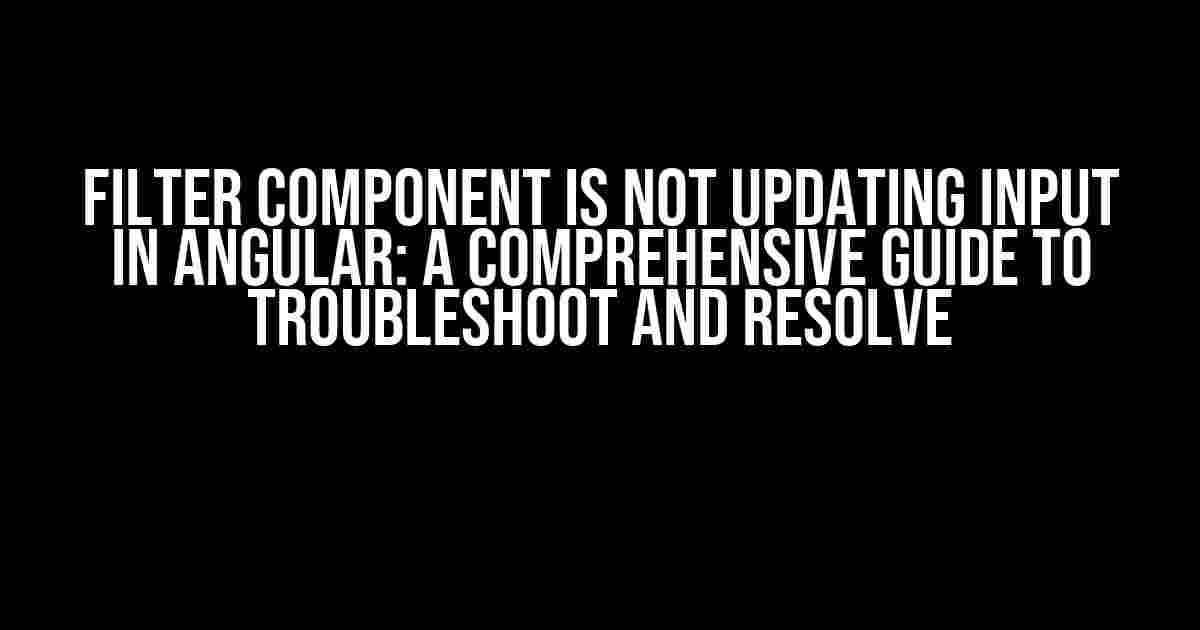Are you tired of struggling with the elusive issue of the Filter Component not updating the Input in your Angular application? You’re not alone! This frustrating problem has plagued many developers, leaving them scratching their heads and wondering what’s gone wrong. Worry no more, dear reader, for we’re about to dive into the depths of this conundrum and emerge victorious on the other side. Buckle up, and let’s get started!
Understanding the Filter Component and Input in Angular
Before we dive into the troubleshooting process, it’s essential to understand the core concepts of the Filter Component and Input in Angular.
The Filter Component
The Filter Component is a powerful tool in Angular that allows you to filter an array of data based on certain criteria. It’s commonly used in scenarios where you need to display a subset of data to the user, such as in search filters or data tables.
<filter-component [data]="users" [filter]="searchTerm"></filter-component>In the above example, the Filter Component takes two inputs: `data` (the array of users) and `filter` (the search term). It then filters the `data` array based on the `filter` input, returning a new array of filtered results.
The Input in Angular
In Angular, Input is a decorator that allows you to pass data from a parent component to a child component. It’s a fundamental concept in Angular, enabling component reuse and modularity.
<component>
<input type="text" [(ngModel)]="searchTerm">
</component>In the above example, the `searchTerm` input is bound to the `ngModel` directive, which updates the `searchTerm` variable whenever the user types something in the input field.
Troubleshooting the Issue
Now that we’ve covered the basics, let’s get down to business. If your Filter Component is not updating the Input in your Angular application, here are some common culprits to investigate:
1. Binding Issues
One of the most common causes of this issue is incorrect binding between the Filter Component and the Input. Make sure you’re using the correct syntax and that the `filter` input is properly bound to the `searchTerm` variable.
<filter-component [data]="users" [(filter)]="searchTerm"></filter-component>In the above example, we’re using the `[( )]` syntax to create a two-way binding between the `filter` input and the `searchTerm` variable. This ensures that whenever the user types something in the input field, the `filter` input is updated, and vice versa.
2. Change Detection
Angular’s change detection mechanism can sometimes cause issues with bindings and updates. To troubleshoot this, try injecting the `ChangeDetectorRef` service and calling the `detectChanges()` method explicitly.
import { ChangeDetectorRef } from '@angular/core';
@Component({
selector: 'app-filter',
template: '<filter-component [data]="users" [(filter)]="searchTerm"></filter-component>'
})
export class FilterComponent {
constructor(private cd: ChangeDetectorRef) { }
onInputChange() {
this.cd.detectChanges();
}
}In the above example, we’re injecting the `ChangeDetectorRef` service and calling the `detectChanges()` method whenever the `searchTerm` variable changes. This forces Angular to re-render the component and update the bindings.
3. Async Pipe
If you’re using an async pipe to render the filtered data, make sure you’re handling the promise correctly. An async pipe can sometimes cause issues with bindings and updates.
<ul>
<li *ngFor="let user of (users | async | filter: searchTerm)">{{ user.name }}</li>
</ul>In the above example, we’re using the async pipe to render the filtered data. Make sure you’re handling the promise correctly by using the `async` pipe and waiting for the data to resolve before rendering the component.
4. component Lifecycle Hooks
Sometimes, the issue can be related to the component lifecycle hooks. Make sure you’re not using the wrong lifecycle hook or that you’re not updating the component state incorrectly.
import { Component, OnInit } from '@angular/core';
@Component({
selector: 'app-filter',
template: '<filter-component [data]="users" [(filter)]="searchTerm"></filter-component>'
})
export class FilterComponent implements OnInit {
users = [];
searchTerm = '';
ngOnInit() {
this.users =(fetchUsersFromApi()); // incorrect update
}
onInputChange() {
this.searchTerm = event.target.value; // correct update
}
}In the above example, we’re using the `ngOnInit()` lifecycle hook to fetch the data from the API. However, this can cause issues with bindings and updates. Instead, update the component state correctly using the `onInputChange()` method.
Best Practices for Avoiding the Issue
To avoid the Filter Component not updating the Input issue in the future, follow these best practices:
1. Use the Correct Syntax
Always use the correct syntax when binding the Filter Component to the Input. Avoid using `{{ }}` interpolation, and instead, use the `[ ]` syntax for one-way binding or `[( )]` syntax for two-way binding.
<filter-component [data]="users" [(filter)]="searchTerm"></filter-component>2. Use the `ChangeDetectorRef` Service
When using the Filter Component, inject the `ChangeDetectorRef` service and call the `detectChanges()` method explicitly to ensure that Angular detects the changes correctly.
import { ChangeDetectorRef } from '@angular/core';
@Component({
selector: 'app-filter',
template: '<filter-component [data]="users" [(filter)]="searchTerm"></filter-component>'
})
export class FilterComponent {
constructor(private cd: ChangeDetectorRef) { }
onInputChange() {
this.cd.detectChanges();
}
}3. Avoid Using Async Pipe Incorrectly
When using the async pipe, make sure you’re handling the promise correctly. Avoid using the async pipe with the Filter Component, and instead, use a separate pipe for filtering the data.
<ul>
<li *ngFor="let user of users | filter: searchTerm">{{ user.name }}</li>
</ul>4. Use the Correct Lifecycle Hooks
When updating the component state, use the correct lifecycle hooks. Avoid using `ngOnInit()` to update the component state, and instead, use the `onInputChange()` method or other relevant lifecycle hooks.
import { Component } from '@angular/core';
@Component({
selector: 'app-filter',
template: '<filter-component [data]="users" [(filter)]="searchTerm"></filter-component>'
})
export class FilterComponent {
users = [];
searchTerm = '';
onInputChange() {
this.searchTerm = event.target.value; // correct update
}
}Conclusion
There you have it, folks! The Filter Component not updating the Input issue in Angular is a common problem that can be resolved with a combination of correct syntax, change detection, and best practices. By following the troubleshooting steps and best practices outlined in this article, you’ll be well on your way to creating robust and maintainable Angular applications.
Remember, the key to resolving this issue is to identify the root cause and apply the correct solution. Whether it’s a binding issue, change detection problem, or async pipe misconfiguration, this article has equipped you with the knowledge and tools to tackle the challenge head-on.
So, go ahead, take a deep breath, and tackle that pesky Filter Component not updating the Input issue once and for all. Your users (and your sanity) will thank you!
| Issue | Solution |
|---|---|
| Binding Issues | Use the correct syntax, [( )] for two-way binding |
| Change Detection | Inject ChangeDetectorRef and call detectChanges() |
| Async Pipe | Handle the promise correctly, avoid using async pipe with Filter Component |
| Component Lifecycle Hooks |
Frequently Asked QuestionsGot stuck with a filter component that refuses to update the input in Angular? Don’t worry, we’ve got you covered! Check out these frequently asked questions and get back on track! Why is my filter component not updating the input in Angular?Ah, the million-dollar question! Make sure you’re using the `ChangeDetectionStrategy` correctly. If you’re using the `OnPush` strategy, Angular won’t detect changes automatically. Try switching to `Default` or `OnPush` with `ChangeDetectorRef` to manually trigger change detection. I’ve checked the ChangeDetectionStrategy, but it’s still not working. What’s next?Don’t worry, my friend! Let’s dive deeper. Check if you’re accidentally using an older version of Angular. The `filter` pipe was deprecated in Angular 5, so you might need to update your Angular version or use an alternative solution like a custom pipe. How do I implement a custom pipe to filter my data?Custom pipes are the way to go! Create a new pipe using the `@Pipe` decorator, and inside the `transform` method, apply your filtering logic. Don’t forget to register the pipe in your module’s declarations. Now, use it in your template like any other pipe – voilà! Why does my filter component only update when I click anywhere on the page?That’s a sneaky one! It’s probably due to Angular’s just-in-time (JIT) compilation. Try enabling AOT (Ahead-of-Time) compilation by adding `aot: true` to your `angular.json` file. This should solve the issue and make your filter component update in real-time. I’ve tried all the above, but my filter component still refuses to update. What’s the final resort?Don’t give up just yet! It’s time to get detective-mode activated. Check the Angular version, filter pipe, and custom pipe implementations. If all else fails, try creating a minimal reproduction of the issue on StackBlitz or JSFiddle and share it with the Angular community for further assistance. |


